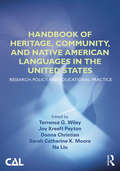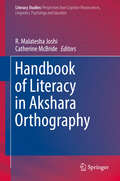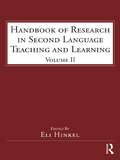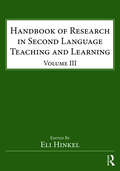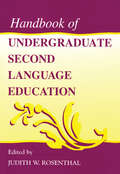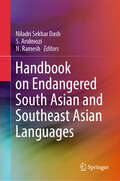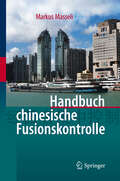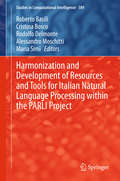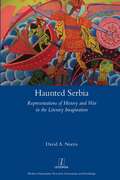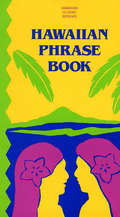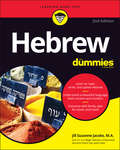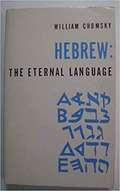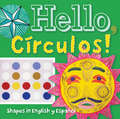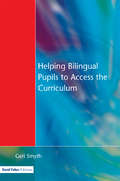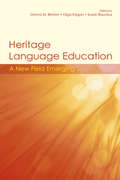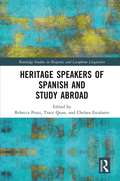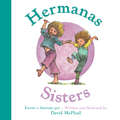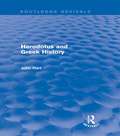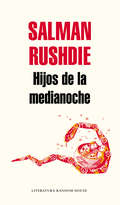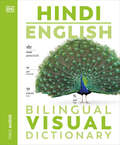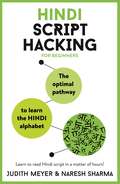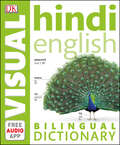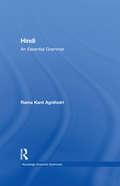- Table View
- List View
Handbook of Heritage, Community, and Native American Languages in the United States: Research, Policy, and Educational Practice
by Sarah Catherine K. Moore Donna Christian Joy Kreeft Peyton Terrence G. Wiley Na LiuCo-published by the Center for Applied Linguistics Timely and comprehensive, this state-of-the-art overview of major issues related to heritage, community, and Native American languages in the United States, based on the work of noted authorities, draws from a variety of perspectives—the speakers; use of the languages in the home, community, and wider society; patterns of acquisition, retention, loss, and revitalization of the languages; and specific education efforts devoted to developing stronger connections with and proficiency in them. Contributions on language use, programs and instruction, and policy focus on issues that are applicable to many heritage language contexts. Offering a foundational perspective for serious students of heritage, community, and Native American languages as they are learned in the classroom, transmitted across generations in families, and used in communities, the volume provides background on the history and current status of many languages in the linguistic mosaic of U.S. society and stresses the importance of drawing on these languages as societal, community, and individual resources, while also noting their strategic importance within the context of globalization.
Handbook of Literacy in Akshara Orthography (Literacy Studies #17)
by R. Malatesha Joshi Catherine McBrideThis volume examines the unique characteristics of akshara orthography and how they may affect literacy development and problems along with the implications for assessment and instruction. Even though akshara orthography is used by more than a billion people, there is an urgent need for a systematic attempt to bring the features, research findings, and future directions of akshara together in a coherent volume. We hope that this volume will bridge that gap. Akshara is used in several Indic languages, each calling it by a slightly different name, for example 'aksharamu', in Telugu, 'akshara' in Kannada, and 'akshar' in Hindi. It is the Bhrami-derived orthography used across much of the Indian subcontinent. There is a growing body of research on the psycholinguistic underpinnings of learning to read akshara, and the emerging perspective is that akshara, even though classified as alphasyllabaries, abugida, and semi-syllabic writing systems, is neither alphabetic nor syllabic. Rather, akshara orthography is unique and deserves to be a separate classification and needs further investigation relating to literacy acquisition in akshara. The chapters in this volume, written by leading authors in the field, will inform the reader of the current research on akshara in a coherent and systematic way.
Handbook of Research in Second Language Teaching and Learning: Volume 2 (ESL & Applied Linguistics Professional Series)
by Eli HinkelThis landmark volume provides a broad-based, comprehensive, state-of-the-art overview of current knowledge and research into second language teaching and learning. All authors are leading authorities in their areas of expertise. The chapters, all completely new for Volume 2, are organized in eight thematic sections: Social Contexts in Research on Second Language Teaching and Learning Second Language Research Methods Second Language Research and Applied Linguistics Research in Second Language Processes and Development Methods and Instruction in Second Language Teaching Second Language Assessment Ideology, Identity, Culture, and Critical Pedagogy in Second Language Teaching and Learning Language Planning and Policy. Changes in Volume 2: captures new and ongoing developments, research, and trends in the field surveys prominent areas of research that were not covered in Volume 1 includes new authors from Asia, Australia, Europe, and North America to broaden the Handbook’s international scope. Volume 2 is an essential resource for researchers, faculty, teachers, and students in MA-TESL and applied linguistics programs, as well as curriculum and material developers.
Handbook of Research in Second Language Teaching and Learning: Volume III (ESL & Applied Linguistics Professional Series)
by Eli HinkelVolume III of the Handbook of Research in Second Language Teaching and Learning, like Volumes I and II, is a comprehensive, state-of-the-art overview of current research into social contexts of second language (L2)/foreign language (FL) teaching and learning; language policy; curriculum; types of instruction; incremental language skills such as listening, speaking, reading, writing, vocabulary, and grammar; international communication; pragmatics; assessment and testing. It differs from earlier volumes in its main purpose—to provide a more in-depth discussion and detailed focus on the development of the essential language skills required for any type of communication: speaking, listening, reading, vocabulary, grammar, and writing. Volume III preserves continuity with previous volumes in its coverage of all the classical areas of research in L2/FL teaching and learning and applied linguistics, but rather than offering a historical review of disciplinary traditions, it explores innovations and new directions of research, acknowledges the enormous complexity of teaching and learning the essential language abilities, and offers a diversity of perspectives. Chapter authors are all leading authorities in their disciplinary areas. What’s new in Volume III? Updates the prominent areas of research, including the sub-disciplines addressed in Volumes I and II, and represents the disciplinary mainstays Considers and discusses perspectives held by different schools of thought on the what, the how, and the why of teaching foundational language skills, including theories, pedagogical principles, and their implementation in practice Captures new and ongoing developments and trends in the key areas of L2/FL teaching and learning, and innovative research topics that have gained substantial recognition in current publications, including the role of corpora, technology, and digital literacy in L2/FL teaching and learning Examines new trends in language pedagogy and research, such as an increased societal emphasis on teaching academic language for schooling, somewhat contradictory definitions of literacy, and the growing needs for instruction in intercultural communication.
Handbook of Undergraduate Second Language Education
by Judith W. RosenthalThis volume offers the most comprehensive, up-to-date description of the wide array of second language programs currently available to undergraduate students in the United States and abroad. It brings together, for the first time, detailed descriptions of programs in foreign language, English as a second language (ESL), dual language (bilingual), American Sign Language, Native American, and heritage languages. Addressing both theory and practice, the volume presents the historical development, current practices, and future directions of each type of program, along with detailed case studies. For second language teachers, academic administrators, and teacher educators, this Handbook provides information that will be useful in making instructional and programmatic planning decisions.
Handbook on Endangered South Asian and Southeast Asian Languages
by Niladri Sekhar Dash S. Arulmozi N. RameshThe handbook delves into the linguistic features of Southeast Asian and South Asian endangered languages, providing detailed descriptions and analyses. Each chapter covers a range of topics, including linguistic properties, extralinguistic aspects, and issues related to preserving and promoting endangered languages. The book also includes an ethnolinguistic profile for each language, discussing its official status, state of endangerment, demography, and usage. It discusses the methodological issues related to collecting and analyzing linguistic data. Furthermore, the book describes the unique linguistic features of each language, covering phonology, morphology, morphosyntax, and other linguistic aspects. By doing so, the book highlights how new linguistic features and findings can reflect on the community. Given the context of UNESCO's declaration of the 'International Decade of Indigenous Languages 2022-2032', this book offers valuable insights for students, researchers, policymakers, government agencies, educators, and linguists. It is an informative volume for scholars working on various endangered languages worldwide.
Handbuch chinesische Fusionskontrolle
by Markus Masseli, Dipl.-Kfm., LL.M.eurDas Handbuch ermöglicht eine Risikoeinschätzung geplanter Fusionen und dient als Argumentationshilfe und Anleitung für Fusionskontrollverfahren in China. Es orientiert sich an den für die Praxis maßgeblichen Gesichtspunkten und geht dabei auf die chinesische Fallpraxis und die Diskussion in der chinesischen Rechtsliteratur ein. Berücksichtigung finden auch die politischen und kulturellen Besonderheiten Chinas. Der Anhang enthält Übersetzungen der wichtigsten Rechtsvorschriften, juristischer Entscheidungen sowie Formulare.
Harmonization and Development of Resources and Tools for Italian Natural Language Processing within the PARLI Project
by Roberto Basili Cristina Bosco Rodolfo Delmonte Alessandro Moschitti Maria SimiThe papers collected in this volume are selected as a sample of the progress in Natural Language Processing (NLP) performed within the Italian NLP community and especially attested by the PARLI project. PARLI (Portale per l'Accesso alle Risorse in Lingua Italiana) is a project partially funded by the Ministero Italiano per l'Università e la Ricerca (PRIN 2008) from 2008 to 2012 for monitoring and fostering the harmonic growth and coordination of the activities of Italian NLP. It was proposed by various teams of researchers working in Italian universities and research institutions. According to the spirit of the PARLI project, most of the resources and tools created within the project and here described are freely distributed and they did not terminate their life at the end of the project itself, hoping they could be a key factor in future development of computational linguistics.
Haunted Serbia: Representations of History and War in the Literary Imagination (Legenda)
by David NorrisHaunting is what happens when the past is disturbed and the victims of previous violence, who are thought to be buried and forgotten, are brought back to the present and made to live again. Serbian fiction writers of the 1980s exhume the ghosts of the past, re-remembering the cruelty of the twentieth century, reinterpreting the heroic role of the Partisans and the extraordinary measures taken to defend Yugoslavia’s recently won independence and socialist revolution. Their uncanny and ghostly imagery challenges the assumptions of the master discourse promoted by the country’s orthodox communist authorities and questions the historical roots of social and cultural identities. The instability of this period of transition is deepened during the wars of the 1990s, when authors turn from the memory of past violence to face the ferocious brutality of new conflicts. The haunting evocations in their work continue to articulate fresh uncertainties as the trappings of modern civilization are stripped away and replaced by the destructive logic of civil war. The past returns once more with renewed energy in the struggle to make sense of a vastly changed world.
Hawaiian Phrase Book
by Charles E. Tuttle Company, Inc.Originally, the primary object of this manual was to teach natives to converse in English. At the same time, the work is designed to assist strangers, speaking English, to acquire the correct colloquial speech of the Hawaiians.
Hebrew For Dummies
by Jill Suzanne JacobsDiscover Hebrew with the world's most straightforward guide to one of the world's most beautiful languages. Shalom! Are you ready to dive into an ancient-yet-modern and rich language full of nuance? Then open up Hebrew For Dummies and get started learning your way around Hebrew by immersing yourself in its sounds and rhythms. You'll start with the basics—like simple grammar and the Hebrew alphabet—before you move onto commonly used phrases and small-talk. This book gets you used to the more unfamiliar sounds of the Hebrew language—like gutturals—that English speakers aren't used to seeing. It will also help you: Recognize what Hebrew has in common with English (and what it doesn't) Learn to read from right to left, get a handle on the basics of Hebrew grammar, and pick up your first few phrases Discover commonly used expressions that help you get around, shop, eat, and have fun Complete with online resources that help you pick up Hebrew by listening to real speakers have actual conversations, Hebrew For Dummies is the perfect companion to help you work your way towards Hebrew fluency!
Hello, Círculos!
by San Antonio Museum of ArtWhat better way to learn shapes than with eye-catching works of art? With art from across Latin America and beyond, children will become armchair world travelers and art connoisseurs. This bilingual edition introduces early readers, and even earlier listeners, to shapes in both English and Spanish.
Hello, Círculos!
by San Antonio Museum of ArtWhat better way to learn shapes than with eye-catching works of art? With art from across Latin America and beyond, children will become armchair world travelers and art connoisseurs. This bilingual edition introduces early readers, and even earlier listeners, to shapes in both English and Spanish.
Helping Bilingual Pupils to Access the Curriculum
by Geri SmythThis book offers practical guidance for teachers working with bilingual pupils in mainstream primary and secondary education and aims to help teachers make the curriculum as accessible as possible to these children. It offers examples of the good practice that has evolved around teaching bilingual children in the classroom.
Heritage Language Education: A New Field Emerging (Routledge Handbooks In Linguistics Ser.)
by Donna M. Brinton Olga Kagan Susan Bauckus"… focuses on issues at the forefront of heritage language teaching and research. Its state-of-the-art presentation will make this volume a standard reference book for investigators, teachers, and students. It will also generate further research and discussion, thereby advancing the field." María Carreira, California State University – Long Beach, United States "In our multilingual and multicultural society there is an undeniable need to address issues of bilingualism, language maintenance, literacy development, and language policy. The subject of this book is timely…. It has potential to make a truly significant contribution to the field." María Cecilia Colombi, University of California – Davis, United States This volume presents a multidisciplinary perspective on teaching heritage language learners. Contributors from theoretical and applied linguistics, sociolinguistics, psychology, educational policy, and pedagogy specialists explore policy and societal issues, present linguistic case studies, and discuss curricular issues, offering both research and hands-on innovation. - The term "heritage language speaker" refers to an individual exposed to a language spoken at home but who is educated primarily in English. Research and curriculum design in heritage language education is just beginning. Heritage language pedagogy, including research associated with the attrition, maintenance, and growth of heritage language proficiency, is rapidly becoming a field in its own right within foreign language education. This book fills a current gap in both theory and pedagogy in this emerging field. It is a significant contribution to the goals of formulating theory, developing informed classroom practices, and creating enlightened programs for students who bring home-language knowledge into the classroom. Heritage Language Education: A New Field Emerging is dedicated to Professor Russell Campbell (1927-2003), who was instrumental in advocating for the creation of the field of heritage language education.
Heritage Speakers of Spanish and Study Abroad (Routledge Studies in Hispanic and Lusophone Linguistics)
by Rebecca PozziHeritage Speakers of Spanish and Study Abroad is an edited volume that provides emerging research on heritage speakers of Spanish in immersion contexts in theoretical, empirical, and programmatic terms. This edited collection seeks to expand our understanding of heritage speakers of Spanish by incorporating research on their linguistic, sociolinguistic, and pragmatic development during and after a sojourn abroad, by discussing the complexities of their identity formation and negotiation during immersive stays, and by highlighting programmatic innovations that could be leveraged to better serve diverse learners in study abroad contexts. This volume advances the fields of both heritage language education and research on immersion study in a variety of ways, and will be of interest to scholars of applied linguistics, sociolinguistics, second language acquisition, and educational linguistics, especially those interested in study abroad programming and Spanish for heritage speakers.
Hermanas/Sisters
by David McPhailSisters can be different in so many ways, but there is one heartfelt way in which they are most alike--they love each other so very much. David McPhail's celebration of the joys—and trials—of sisterhood has been a favorite with sisters of all ages for almost twenty years. Now available in a bilingual edition featuring Spanish and English text set in two colors for easy readability, a new generation of sisters will love to read this treasure . . . together.
Herodotus and Greek History (Routledge Revivals)
by John HartHerodotus has shaped our knowledge of life, religion, war and politics in ancient Greece immeasurably, as well as being one of the most entertaining of all Classical Greek authors: fascinating, perceptive, accessible and not at all pretentious. Herodotus and Greek History, first published in 1982, examines the themes and preoccupations which form the basis for Herodotus’ style of history. The Athenian nobility, important protagonists in the context of what we know of his sources; the human and divine forces, which Herodotus understood as influencing the course of history; and the concepts of character and motivation are all discussed. Herodotus’ treatment of religious belief and oracles, politics and war, and his portrayal of certain prominent individuals are specifically investigated. The final chapter situates Herodotus in his historical context. John Hart’s lucid, well-informed and lively discussion of Herodotus will be value to A-level candidates, school teachers, undergraduates, lecturers and curious non-classicists alike.
Hijos de la medianoche
by Salman RushdieEl destino de Saleem queda inexorablemente unido al de su país, y sus peripecias personales reflejarán siempre la evolución política de la India o serán reflejadas por ella. Es la historia de un hombre dotado de facultades insólitas pero también la de una generación y la de una familia, lo que la convierte en un retrato completo de toda una época y una cultura.Ganadora del prestigioso premio Booker of Bookers, Hijos de la medianoche constituye una asombrosa novela que combina magistralmente magia y humor, compromiso politico fantasía y humanidad.
Hindi - English Bilingual Visual Dictionary (DK Bilingual Visual Dictionaries)
by DKLearn more than 6,000 useful words and phrases in Hindi with this engaging illustrated dictionary.The Hindi English Bilingual Visual Dictionary is your essential companion to learning Hindi - from the million-copy bestselling Bilingual Visual Dictionary series. This handy pocket-size guide has over 6,750 fully illustrated words and phrases in Hindi and English, along with a free bilingual audio app. Learn all the words and phrases you need to buy food and clothes, talk about work and education, visit the doctor, go to the bank, use public transport, and much more.This Hindi-English visual dictionary includes:A fully illustrated bilingual guide for adults.Updated and revised content with new images and vocabulary.A fully updated audio app that allows you to hear all words in both languages.A new edition from the global bestselling Bilingual Visual Dictionary series.Perfect for students, tourists, and business travelers, the dictionary is incredibly easy to follow, with thematically organized vocabulary so you can find closely related words on a particular topic.Words and phrases are illustrated with full-color photographs and artworks, helping to fix new vocabulary in your mind. The supporting audio app enables you to hear all the words and phrases spoken out loud in both languages to help you learn, remember, and pronounce important vocabulary.
Hindi Script Hacking: The optimal pathway to learn the Hindi alphabet
by Naresh Sharma Judith MeyerUsing a unique, tried and tested algorithm, this book teaches you how to quickly and efficiently recognise letters and common words in Hindi (Devanagari) script. Whether you're travelling and want to understand the words around you, or preparing to learn Hindi and want to master the basics, this is the book for you. In this book you will find: · An introduction to Hindi (Devanagari) script· Plenty of practice activities to help you recognise each letter of the alphabet · Helpful mnemonics to make you remember the shape of each letter· Accompanying audio files so you know how to pronounce letters and words · Handy tips to help you decipher common and familiar words The audio for this course can be downloaded from the Teach Yourself Library app or streamed at library.teachyourself.com.Rely on Teach Yourself, trusted by language learners for 80 years.
Hindi Script Hacking: The optimal pathway to learn the Hindi alphabet
by Naresh Sharma Judith MeyerUsing a unique, tried and tested algorithm, this book teaches you how to quickly and efficiently recognise letters and common words in Hindi (Devanagari) script. Whether you're travelling and want to understand the words around you, or preparing to learn Hindi and want to master the basics, this is the book for you. In this book you will find: · An introduction to Hindi (Devanagari) script· Plenty of practice activities to help you recognise each letter of the alphabet · Helpful mnemonics to make you remember the shape of each letter· Accompanying audio files so you know how to pronounce letters and words · Handy tips to help you decipher common and familiar words The audio for this course can be downloaded from the Teach Yourself Library app or streamed at library.teachyourself.com.Rely on Teach Yourself, trusted by language learners for 80 years.
Hindi-English Bilingual Visual Dictionary (DK Bilingual Visual Dictionaries)
by DKWith more than 6,500 fully illustrated words and phrases in Hindi and English, along with a free bilingual audio app, Hindi language learning has never been easier. Perfect for tourists and business travelers alike, DK's Hindi English Bilingual Visual Dictionary is your essential companion when buying food, talking about work, discussing health, and studying language.The dictionary is incredibly easy to follow, with thematically organized vocabulary so you can find closely related words on a particular topic. Words and phrases are illustrated with full-color photographs and illustrations, helping to cement new vocabulary in your mind. A comprehensive two-way index provides an instant reference point for new Hindi vocabulary.The supporting audio app enables you to hear more than 6,500 words and phrases spoken out loud in both Hindi and English. Available on the App Store and Google Play, the audio app is easy to use and provides an intuitive reference for language learning, helping you learn, retain, and pronounce important vocabulary. The dictionary gives a pronunciation guide for every Hindi word, and you can use this alongside the app to perfect your pronunciation.
Hindi: An Essential Grammar (Routledge Essential Grammars)
by Rama Kant AgnihotriThis text provides a reader-friendly guide to the structural patterns of modern standard Hindi. Ideal for both independent learners and classroom students alike, this book covers the essentials of Hindi grammar in readable, jargon-free sections. Key features include: sections on the speech sounds of Hindi detailed analysis of Hindi sentence structure full examples throughout.
